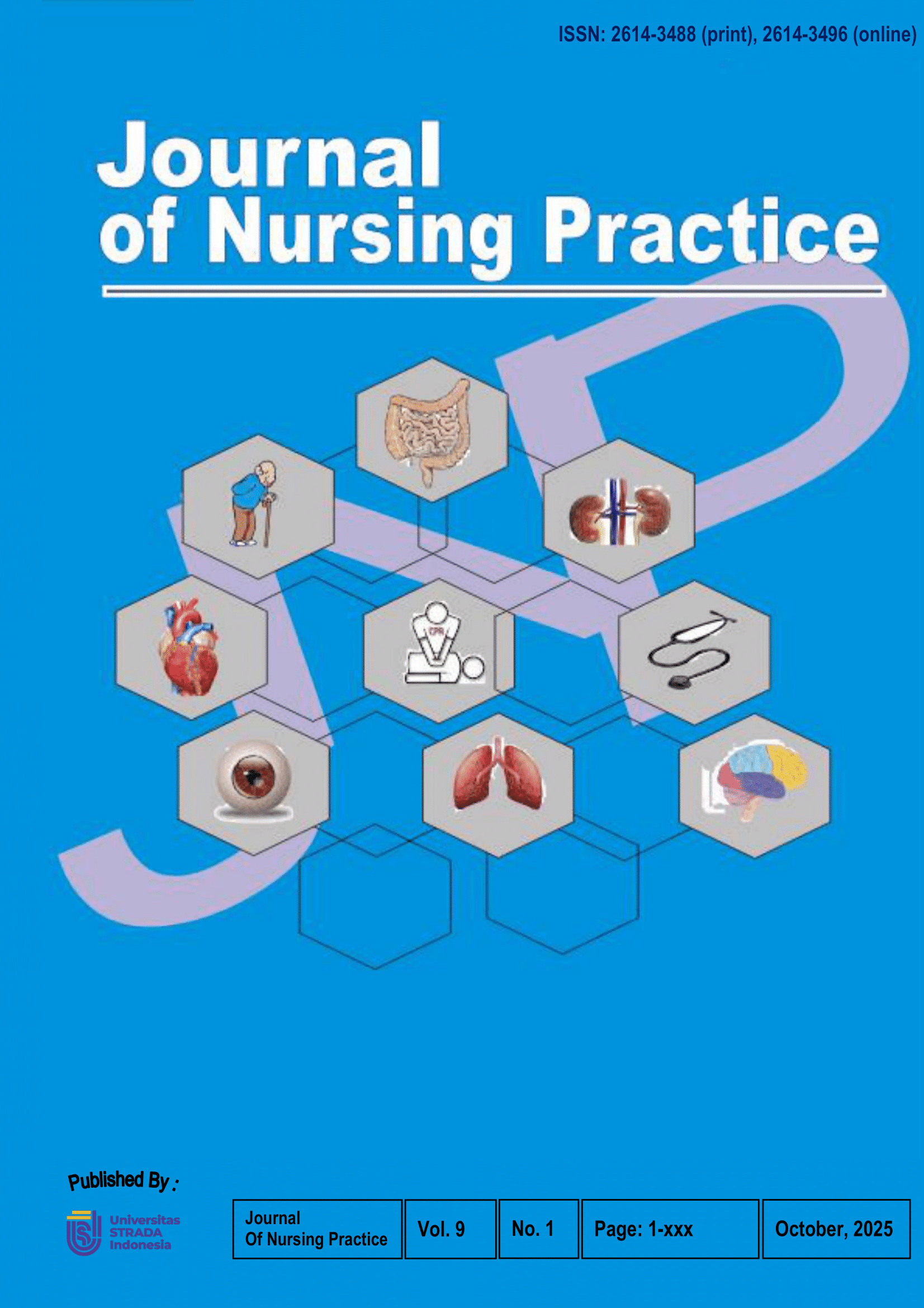Analysis of Factors Associated with Acute Myocardial Infarction (AMI)
DOI:
https://doi.org/10.30994/jnp.v9i1.419Keywords:
acute miocard infarction, cholesterol, factors amiAbstract
Background: The high mortality and morbidity rates for AMI are caused by delays in treatment efforts, accuracy and speed of diagnosis, and treatment by doctors. There are risk factors that may increase the risk of experiencing an acute myocardial infarction such as age, gender, race, genetics, overweight or obesity, smoking, hyperlipidemia, history of hypertension, diabetes mellitus, stress, and lack of physical activity.
Purpose: The purpose of this study was to analyze what factors were associated with the incidence of acute myocardial infarction (AMI) at the Heart Polyclinic at Bhakti Dharma Husada Hospital, Surabaya.
Methods: Analytical research design with cross-sectional approach. The population of this study were patients at the cardiac specialist polyclinic with a diagnosis of AMI with as many as 50 respondents. Sampling technique Non-probability sampling and the technique used is Consecutive sampling. Variables in the Independent Variable (Independent Variable) study were age, gender, hypertension, smoking, cholesterol, diabetes, obesity, physical activity. The dependent variable in this study was the incidence of acute myocardial infarction.
Results: The results of the study used the Chi Squared tests (α = 0.05) to obtain a ρ-value Age = 0.004, Gender = 0.001, HT = 0.004, Cholesterol = 0.000, Smoking = 0.001, DM = 0.035, BMI = 0.018, Activities = 0.265. This means that there is a relationship between Age, Gender, Cholesterol, Smoking, DM, BMI with the incidence of AMI, and there is no relationship between Activity and the occurrence of AMI.
Conclusion: Factors such as age, gender, hypertension, cholesterol, smoking habits, diabetes mellitus, and obesity have been shown to be significantly associated with the incidence of acute myocardial infarction, so that identification and control of these factors are important for the prevention and management of cases in the community. If left for a long time and education is not carried out as early as possible, it will impact the health of the community, which is at risk of more incidents than people who are not exposed to this education.
Downloads
References
Aini, D. N. (2016). Strong traditional risk factors for first onset of acute myocardial infarction at RSUD Dr. Sutomo Surabaya. [Unpublished undergraduate thesis]. Airlangga University.
Alan, S. G., et al. (2013). Heart disease and stroke statistics—2013 update: A report from the American Heart Association. Circulation, 127, e6–e245. https://doi.org/10.1161/CIR.0b013e31828124ad.
Ali, M. K., Venkat, K. M., & Tandon, N. (2018). Diabetes and coronary heart disease: Current perspectives. Indian Journal of Medical Research, 132, 584–597.
Amalia, R., Yaswir, R., & Prihandani, T. (2019). Description of homocysteine in acute myocardial infarction patients at Dr. M Djamil Padang. Jurnal Kesehatan Andalas, 8(2), 351.
Ambari, A. M., et al. (2025). Indonesia-INTERASPIRE study: An Indonesian cross-sectional multicenter survey on cardiovascular secondary prevention in coronary heart disease. Medical Journal of Indonesia, 34(2), 158–169. https://doi.org/10.13181/mji.bc.2347833.
Amelia, F., & Mahalul, A. (2015). Risk factors associated with coronary heart disease in middle adulthood (41-60 years): A case study in a public hospital in the city of Semarang. UJPH, 4(2), 117–123.
American Heart Association. (2014, February). Obesity information. http://www.heart.org/HEARTORG/GettingHealthy/WeightManagement/Obesity/Obesity-Information_UCM_307908_Article.jsp.
American Heart Association. (2014, September). Coronary artery disease – Coronary heart disease. http://www.heart.org/HEARTORG/Conditions/More/MyHeartandStrokeNews/Coronary-Artery-Disease---Coronary-Heart-Disease_UCM_436416_Article.jsp.
Andi, A. F. (2014). Analysis of risk factors for coronary heart disease at a young age at Abdul Wahab Sjahranie Hospital, Samarinda. [Undergraduate thesis]. Mulawarman University.
Anindya, K., Defi, I. R., & Purnamasari, N. (2022). Low physical activity is associated with adverse health outcomes and higher health care costs in Indonesia. Frontiers in Cardiovascular Medicine, 9, Article 972461. https://doi.org/10.3389/fcvm.2022.972461.
Arlindyo, M. V. B., et al. (2024). Analysis of risk factors for acute myocardial infarction. Averrous Medical Journal, 10(2).
Arlindyo, M. V. B., Rafi, A. I., Fauzan, M. I., Wulandari, N. P., & Rahmawati, A. (2024). Analysis of risk factors for acute myocardial infarction. Averrous Medical Journal, 10(2), 21–27. https://ojs.unAMIl.ac.id/averrous/article/view/18092.
Asleh, R., et al. (2020). Sex differences in outcomes after myocardial infarction complicated by heart failure. Journal of the American Heart Association, 9(13).
Broniuk, A. L. V., et al. (2024). Gender features of the course of acute myocardial infarction. Vietnam Medical Reports, 7(3).
Brown, J. C., Yates, T., & Davis, M. G. (2023). Risk factors for coronary artery disease. In StatPearls. StatPearls Publishing. https://www.ncbi.nlm.nih.gov/books/NBK554410/.
BudAMIn, B., Sihombing, R., & Pradina, P. (2017). Relationship of dyslipidemia, hypertension, and diabetes mellitus with acute myocardial infarction. Jurnal Kesehatan Masyarakat Andalas, 10(1), 32.
Centers for Disease Control and Prevention. (2014, November). Smoking and tobacco use. http://www.cdc.gov/tobacco/basic_information/health_effects/-heart_disease/.
Chia, Y. C., et al. (2015). Validation of the Framingham general cardiovascular risk score in a multiethnic Asian population: A retrospective cohort study. BMJ Open, 5, e007324. https://doi.org/10.1136/bmjopen-2014-007324.
Cui, J., Liu, Y., Li, Y., Xu, F., & Liu, Y. (2021). Type 2 diabetes and myocardial infarction: Recent clinical evidence and perspective. Frontiers in Cardiovascular Medicine, 8, Article 644189. https://doi.org/10.3389/fcvm.2021.644189.
Daan, K., Alessandro, M., Hugo, K., & Susana, S. (2013). Prevention of coronary heart disease by diet and lifestyle: Evidence from prospective cross-cultural, cohort, blood pressure in adults: Report from the panel members appointed to the eighth joint national committee (JNC 8). JAMA, e1–e14. https://doi.org/10.1001/jama.2013.284427.
Dutta, D., et al. (2024). Gender differences in the management and outcomes of acute myocardial infarction. Indian Heart Journal, 76(2).
Eckel, R. H., et al. (2014). 2013 AHA/ACC guideline on lifestyle management to reduce cardiovascular risk: A report of the American College of Cardiology/American Heart Association Task Force on Practice Guidelines. Journal of the American College of Cardiology, 63, 2960–2984.
Fadma, Y., Fadil, O., & Detty, I. (2014). The relationship of various risk factors to the incidence of coronary heart disease in patients with type 2 diabetes mellitus [Research article]. Jurnal Kesehatan Andalas, 3(1), 37–40. http://jurnal.fk.unand.ac.id.
Fahmi, I., Nurachmah, E., Yona, S., & Herawati, T. (2023). Physical activity and associated factors in Indonesian patients with acute myocardial infarction. Evidence Based Care Journal, 13(4), 103–108. https://doi.org/10.22038/ebcj.2023.64980.3164.
Framingham Heart Study. (2014). Coronary heart disease (10-year risk). https://www.framinghamheartstudy.org/risk-functions/coronary-heart-disease/10-year-risk.php.
Harvey, A., et al. (2024). Gender differences in trends in incidence and mortality of acute myocardial infarction. Cardiology, 149(2).
Heusch, G. (2024). Translational pathophysiology of ischemic heart disease. Current Opinion in Cardiology, 39(2), 87–94. https://www.sciencedirect.com/science/article/pii/S2666634023004051.
Indonesian Ministry of Health. (2018). Main result of Riskesdas 2018 (in Bahasa Indonesia). Jakarta: Ministry of Health of the Republic of Indonesia. http://www.depkes.go.id/resource/dwonload/info.
Lilly, L. S. (2011). Pathophysiology of heart disease: Atherosclerosis (Issue 5, pp. 113–133). Philadelphia: Lippincott Williams & Wilkins.
Mechanic, O. J., & Gavin, M. (2023). Acute myocardial infarction. StatPearls. StatPearls Publishing.
Mechanic, O. J., & Gavin, M. (2023). Acute myocardial infarction. In StatPearls. StatPearls Publishing. https://www.ncbi.nlm.nih.gov/books/NBK459269/.
Mozaffarian, D., et al. (2015). Heart disease and stroke statistics—2015 update: A report from the American Heart Association. Circulation, 131, e29–e322. https://doi.org/10.1161/CIR.0000000000000152.
Muhammad, G., & Ardhianto, P. (2015). Profile of atherosclerotic risk factors in acute myocardial infarction with ST-segment elevation in Dr. Kariadi Hospital, Semarang. Young Medical Media, 4(4), 849–858.
Myers, J. (2003). Cardiology patient page: Exercise and cardiovascular health. Circulation, 107, e2–e5. https://doi.org/10.1161/01.CIR.0000048890.59383.8d.
Nardian, D. F., Subijanto, A. A., & Mashuri, Y. E. S. (2016). Relationship between smoking severity and myocardial infarction prevalence. Nexus Community Kedokteran, 5(2), 79–80.
Natarajan, P., Kausik, K. R., & Christopher, P. C. (2010). High-density lipoprotein and coronary heart disease: Current and future therapies. Journal of the American College of Cardiology, 55(13), 1283–1299. https://doi.org/10.1016/j.jacc.2010.01.008.
National Diabetes Information Clearinghouse. (2014, June). Diagnosis of diabetes and prediabetes. https://diabetes.niddk.nih.gov/dm/pubs/diagnosis/diagnosis_508.pdf.
National Heart, Lung, and Blood Institute. (2014, November). Risk assessment tool for estAMIting your 10-year risk of having a heart attack. https://cvdrisk.nhlbi.nih.gov/.
Ngaruiya, C., et al. (2024). Identification of gender differences in acute myocardial infarction. JMIR Formative Research, 8(1).
Nurmohamed, N. S., et al. (2025). First myocardial infarction: Risk factors, symptoms, and medical therapy in older vs younger patients. European Heart Journal, ehaf390.
Pana, T. A., et al. (2025). Sex differences in myocardial infarction care and outcomes: A population-based study. European Journal of Preventive Cardiology, 32(8), 696–707.
Paul, S. J., et al. (2012). American Association of Clinical Endocrinologists guidelines for management of dyslipidemia and prevention of atherosclerosis. Endocrine Practice, 18(1), 10.
Price, S. A., & Wilson, L. M. (2012). Pathophysiology: Clinical concepts of disease processes. Jakarta: EGC.
Qodir, A. (2016). Media Husada health scientific journal. JIL Health Media Husada, 5(1).
Rajati, F., et al. (2024). The prevalence of myocardial infarction in the elderly: A systematic review and meta-analysis. Journal of Cardiovascular Aging, 11, e240325.
Riskesdas. (2018). Riskesdas report 2018, Southeast Sulawesi. Jakarta: Author.
Sagris, M., et al. (2024). Young and older patients with acute myocardial infarction. Hellenic Journal of Cardiology, 85, 33–40.
Sarganas, G., Liew, A., & Davis, A. M. (2024). Symptoms, outcomes and risk factors of acute coronary syndrome presentations without chest pain: A review. European Cardiology Review, 19(1), 23–28. https://www.ecrjournal.com/articles/symptomology-outcomes-and-risk-factors-acute-coronary-syndrome-presentations-without.
Smeltzer, S. G., & Bare, B. G. (2018). Textbook of medical surgical nursing (11th ed.). Philadelphia: Kluwer.
Sweeny, J. M., & Benamer, H. (2025). Gender outcomes in acute myocardial infarction. EuroIntervention, 20(6).
Sylvia, A. P., & Lorraine, M. (2014). Pathophysiology: Clinical concepts of disease processes. Volume 1: Chapter 31 coronary atherosclerotic disease (pp. 576–611). Jakarta: EGC.
The American Association of Clinical Endocrinologists & The American College of Endocrinology. (2014). 2014 advanced framework for a new diagnosis of obesity as a chronic disease. Washington, D.C.: Author.
Wandari, A. (2016). The relationship between physical activity and BMI in clients with coronary heart disease. [Undergraduate thesis]. Sari Mulia College of Health Sciences Banjarmasin.
Wardhani, R. L., Mahmudah, N., Nurhayani, & Nursanto, D. (2019). Correlation between ratio total cholesterol to HDL and blood glucose levels in patients with NSTEMI and STEMI. Publication Manuscript of the Faculty of Medicine, University of Muhammadiyah Surakarta, 360–371.
Widyawati. (2021). Coronary heart disease dominated by city people. https://sehatnegeriku.kemkes.go.id/baca/umum/20210927/5638626/penyakitjantung%20koroner-didominasi-masyarakatkota/.
World Health Organization. (2013). Cardiovascular diseases fact sheets. http://www.who.int/mediacentre/factsheets/fs317/en/.
World Heart Federation. (2012, April). Cardiovascular disease: Risk factors (fact sheets). http://www.world-heart-federation.org/fileadmin/user_upload/documents/Fact_sheets/2012/PressBackgrounderApril2012RiskFactors.pdf.
Downloads
Published
How to Cite
Issue
Section
License
Copyright (c) 2025 Journal Of Nursing Practice

This work is licensed under a Creative Commons Attribution-NonCommercial-ShareAlike 4.0 International License.

This work is licensed under a Creative Commons Attribution-NonCommercial-ShareAlike 4.0 International License.






















